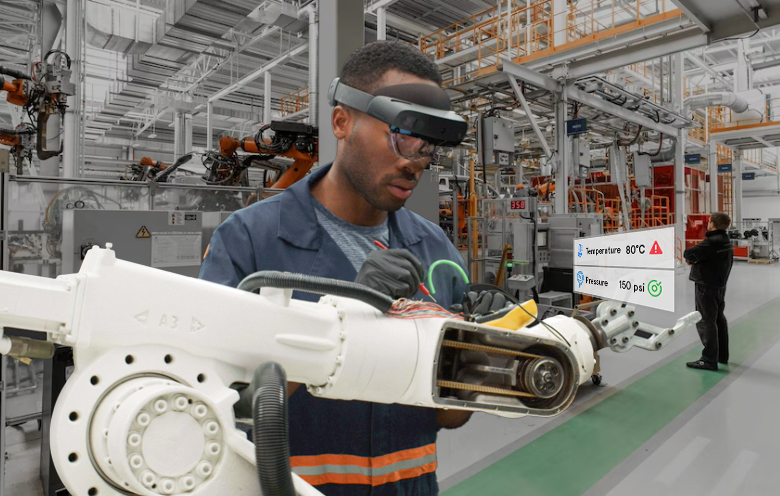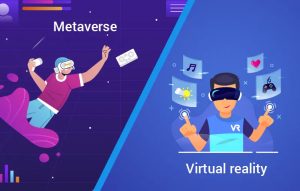Welcome to the industrial metaverse, a world where industries converge to unlock limitless possibilities. Here, engineers design and test virtual prototypes, supply chains are optimized in real-time, and workers are trained in a safe and controlled environment. With the metaverse’s boundless potential, modern industries are revolutionizing planning, production and innovation.
How the industrial metaverse is transforming businesses: real-world use cases
While the metaverse has been around for decades, its use cases have expanded significantly in recent years, particularly in the industrial sector. In this blog, we will explore the applications and use cases of the metaverse in the manufacturing industry.
1. Industrial design and engineering
Design in the metaverse can also improve design in the real world. For large-scale products like airplanes designing in the metaverse could mean collaborating in real-time inside a virtual model of the airplane interior. Instead of spending money and time building or printing a 3D model or prototype, parts could be tested, revised and iterated in seconds.
Metaverse gives your engineers the flexibility to create industrial designs with precise detailing. They use virtual reality to see the product in a real-world setting, interact with it and modify the design. This approach saves time and reduces physical prototyping costs, allowing you to innovate faster with efficiency.
Moreover, the metaverse provides designers and engineers with new perspectives and ideas, allowing them to create more innovative and functional designs. Industrial metaverse apps can help you streamline design, engineering processes and bring better products to market faster.
2. Supply chain management and logistics
With industrial metaverse development, you can transform end-to-end supply chain network mapping into virtual reality. Whether it’s tracing the journey from manufacturers to shoppers or distributors to retailers, the metaverse can map out all the stakeholders involved in the entire supply chain. This includes warehouses, factories, distribution centers, or transportation routes.
This virtual representation can be used to optimize the flow of goods, identify potential bottlenecks and reduce waste.
TradeLens and VeChain are exemplary use cases of the industrial metaverse. They showcase how this technology can be leveraged to optimize and streamline supply chain operations.
- The TradeLens platform uses smart contracts and digital signatures to automate and digitize supply chain processes, reducing paper-based documentation and manual processes.
- VeChain uses blockchain technology and the metaverse to create a virtual representation of each step in the supply chain, from raw materials to finished products. It uses blockchain technology to record every transaction and movement.
3. Manufacturing operations and maintenance
The metaverse has made it possible for us to experience the real world virtually from anywhere at any given time. Traditional manufacturing relied on physical processes and machinery but is transforming with the metaverse. Metaverse applications in the manufacturing industry are revolutionizing how products are designed, produced and maintained. This leads to increased efficiency, reduced costs and improved product quality.
Emerging technologies such as HoloLens 2 enable industries to perform tasks more efficiently. This is illustrated in the latest Dynamics 365 Guides. This seamlessly integrates two mixed reality apps to create a unified experience, resulting in improved productivity and workflow integration.
Let’s check how the metaverse applications in the manufacturing industry improve operational efficiency.
Improve product design
Product designers are now using the metaverse to easily simulate and test manufacturing processes without time-consuming and costly physical testing. By simply dragging and dropping assets into digital twin simulations, designers can quickly identify ways to improve safety and efficiency in product manufacturing.
Enhance the production and manufacturing process
Metaverse simulations provides you with the capability to test several factory scenarios and gain insights from scaling up or reducing production. Through these simulations, you can identify optimization opportunities within their facilities without disturbing existing production.
In a smart factory, operators can use Microsoft Dynamics 365 Guides for real-time instructions overlaid on equipment, while IoT sensors collect data on machine performance, quality metrics and inventory levels. This enables operators to swiftly identify and resolve issues, optimize production parameters and improve overall manufacturing efficiency and quality.
Improve quality control
By integrating IoT sensors into their manufacturing processes, you can collect real-time data from various equipment and machinery. Data is transmitted to the metaverse for analysis and visualization. This enables you to virtually inspect equipment and proactively identify potential problems like abnormal vibrations, temperature variations and other anomalies that may indicate equipment failure.

Source: https://techcommunity.microsoft.com/t5/mixed-reality-blog/intuitive-improvements-to-dynamics-365-guides/ba-p/3790361
The use of metaverse applications in the manufacturing industry, and technologies like augmented reality (AR) and virtual reality (VR), enable manufacturers to optimize operations and improve productivity.
With Dynamics 365 Guides and Remote Assist, an expert can now leverage 3D drawing in your real-world environment. Likewise, frontline workers wearing HoloLens can also annotate their physical space with digital ink, creating an interactive and immersive experience.
For instance, BMW workers wear headsets that overlays digital information onto real-world objects. This allows them to visually inspect and identify defects in the components in real-time, reducing the risk of defective products reaching the assembly line or being shipped to customers.
Better warehouse and logistics management
By harnessing metaverse technology, you can optimize logistics and warehousing processes using AR.
For example DHL, a global logistics company is using augmented reality (AR) headsets to provide their workers with real-time information, such as order details, inventory locations and picking instructions, overlaid onto their field of vision. This allows their workers to work hands-free and efficiently navigate the warehouse, reducing errors and improving order accuracy.
4. Training
As mechanical and digital technologies advance in complexity, enterprises require a highly skilled workforce to operate efficiently. Immersive experiences, such as AR and VR simulations, offer just the right environment for training new and current employees. You can leverage the industrial metaverse for business use cases, such as virtual training and remote collaboration. This is to enhance employee skills and productivity in the manufacturing industry.
Trainees can practice operating complex machinery, undergo safety training, learn maintenance and repair tasks, conduct remote training and develop essential soft skills. This facilitates a more efficient and well-trained workforce.
Trainees and employees can now leverage Dynamics 365 Guides’ advanced capabilities, which include pre-join settings for HoloLens users joining Teams calls, allowing them to toggle video and mute themselves before entering the call. Users can also adjust these settings during the meeting. In spaces where confidentiality is paramount, this also lets frontline workers use the HoloLens as their primary calling device – without compromising security.
Dynamics 365 Guides make navigating through a document easy. This also has the added ability to link directly from one guide to another through action steps. This allows seamless navigation between different training materials or guides, like clicking on hyperlinks to jump to different web pages.
These innovative training methods offer a safe and controlled environment for hands-on learning, leading to increased efficiency, reduced costs, and improved safety in industrial settings.
5. Marketing and sales for manufacturing products
Metaverse enables you to create virtual product experiences that allow customers to visualize and interact with products in a virtual environment. Metaverse has created numerous possibilities for industries to market their products by organizing:
- Virtual product launches use the metaverse to launch brand-new products. Companies can create virtual launch events where users can virtually experience the new products, learn about their features and even pre-order them. This creates buzz and anticipation among their customer bases.
- Virtual factory tours help customers connect with your brand. This allows them to experience the manufacturing process and get an inside look at your facilities without physically visiting the factories.
- Virtual booths at trade shows to showcase your products to a global audience. These booths can engage visitors and demonstrate your products using virtual presentations, videos, or interactive demos. Virtual trade shows offer a cost-effective and environmentally friendly way to market your products and reach potential customers globally.
6. Research and development
Industrial metaverse apps have emerged as a game-changer with its immersive and collaborative capabilities, revolutionizing the way industries are conducting research and development (R&D). This ultimately leads to unprecedented levels of innovation, efficiency and creativity.
Gone are the days where physical prototypes were used to conduct R&D on products, which was time-consuming and costly. The use of industrial metaverses such as to create and test virtual prototypes in immersive environments provides you with opportunities to optimize your operations and reduce costs.
For example, Ford, one of the world’s leading automakers, has been exploring the use of the metaverse for R&D in areas such as vehicle design, safety testing, and manufacturing optimization. They have used virtual reality (VR) simulations to create virtual prototypes of their vehicles and conduct virtual tests for safety and performance.
Unlock endless innovation possibilities with the metaverse
The metaverse has expanded the possibilities for industries, providing new perspectives, ideas and efficiencies in various aspects of manufacturing processes. As technology continues to advance, industrial metaverse development is expected to play a crucial role in shaping manufacturing operations’ future. Softweb Solutions is a leading expert in leveraging industrial metaverse innovation, empowering businesses to harness its boundless potential.







